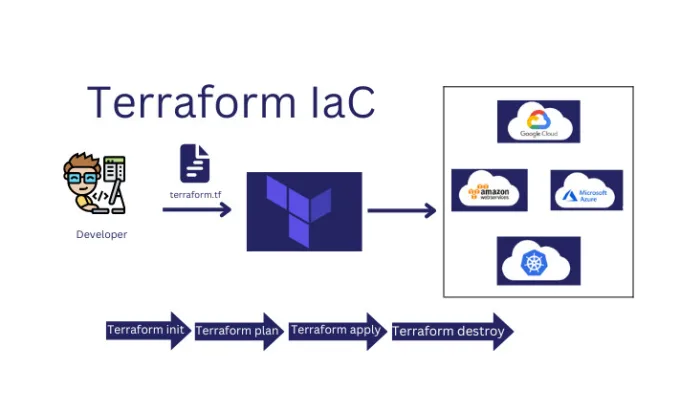Terraforming Your Cloud: Automating Infrastructure Provisioning Made Simple
Terraforming Your Cloud: Unveiling the Secrets of Automated Infrastructure Provisioning
In today's fast-paced IT landscape, agility and scalability are paramount. Manual infrastructure management is becoming a relic of the past, replaced by the streamlined efficiency of automation. At the forefront of this revolution is Terraform, the leading Infrastructure as Code (IaC) tool. This comprehensive guide will explore the power of Terraform, showing you how it simplifies infrastructure provisioning, accelerating delivery and enhancing reliability.
Why Choose Terraform for Infrastructure as Code (IaC)?
Terraform, a brainchild of HashiCorp, lets you define your cloud infrastructure using a declarative language. Unlike traditional methods, where a single change can consume hours of manual work, Terraform guarantees consistency and accuracy by automating the entire infrastructure lifecycle. Let's delve into its key advantages:
Multi-Cloud Mastery: AWS, Azure, GCP, and Beyond
Terraform isn't confined to a single cloud provider. It seamlessly integrates with AWS, Azure, Google Cloud Platform (GCP), and many others, providing unparalleled flexibility and freedom from vendor lock-in. This means you can manage resources across multiple clouds using a single, unified tool. This flexibility is crucial for businesses using a hybrid cloud approach or those seeking to avoid dependency on a single cloud vendor.
Imagine the scenario of needing to deploy resources across AWS for storage, Azure for compute, and GCP for databases. Terraform allows you to define all of these resources within the same infrastructure definition, ensuring consistency and ease of management, no matter the underlying cloud provider.
Declarative Syntax: Defining Your Ideal Infrastructure State
With Terraform, you specify your desired state of infrastructure, leaving the execution details to the tool. This declarative approach contrasts sharply with imperative methods that require you to detail each step of the process. This declarative nature significantly simplifies the process and reduces errors.
Instead of painstakingly outlining every command needed to set up a server, you simply declare the server's specifications (e.g., instance type, operating system, security settings). Terraform then handles the complexities of provisioning, ensuring that the final result matches your precise requirements.
State Management: Tracking Your Resources for Seamless Control
Terraform diligently tracks your existing resources, preventing accidental duplication or unintended changes. This state management feature ensures that only necessary modifications are applied during updates. It is a core component for preventing unintended consequences and maintaining a consistent, predictable infrastructure.
Consider a scenario where you accidentally modify your Terraform configuration to create another instance of a service that already exists. Terraform's state management would identify this redundancy and prevent the creation of the duplicate instance, saving you potential headaches and resource waste.
Reusability: Building Modular Configurations for Efficient Deployments
Terraform encourages a modular approach to infrastructure definition. You can create reusable components, significantly speeding up development and reducing redundancy. This modularity ensures consistency across different projects and environments.
Imagine you have a standard set of security group configurations that are necessary for every server you deploy. By defining these configurations once as a module, you can reuse it across any project requiring those security configurations, reducing development time and improving consistency across your infrastructure.
To gain hands-on expertise in Terraform and master automation in DevOps, enroll in the Apnaguru Fullstack DevOps course today. Visit Apnaguru and accelerate your career with industry-relevant skills!
Mastering the Terraform Workflow: A Step-by-Step Guide

Terraform's workflow is elegant in its simplicity, consisting of four core stages:
Write: Crafting Infrastructure Definitions with HCL
You define your infrastructure using HashiCorp Configuration Language (HCL), a human-readable language designed for expressing infrastructure as code. The HCL files (typically with a .tf extension) contain the complete blueprint for your desired infrastructure. This is where the magic begins – defining the resources, their specifications, and their relationships.
Think of the HCL files as architectural blueprints for your infrastructure. Within them, you define every element, from the foundation (networks and virtual private clouds) to the superstructure (servers and applications). Terraform takes these blueprints and turns them into reality.
Plan: Previewing Changes Before Execution
Before making any changes to your live infrastructure, you use the terraform plan command to preview the effects of your configuration changes. This crucial step allows you to review the planned modifications and verify that they align with your expectations. It prevents unintentional changes and ensures a smooth transition.
The terraform plan command generates a detailed report of the actions Terraform will take, showing resource creations, modifications, and deletions. This allows for thorough review before you commit to the changes, mitigating potential risks.
Apply: Bringing Your Infrastructure to Life
Once you've reviewed the plan and are satisfied with the changes, execute terraform apply. This command brings your desired infrastructure to life, creating or modifying resources in the cloud based on your configuration. This is the moment you see your declarative infrastructure definition become a tangible reality.
The terraform apply command will execute the changes outlined in the plan, provisioning and configuring the necessary resources. It's critical to carefully review the plan before applying to ensure the outcome matches expectations.
Destroy: Safely Cleaning Up Resources
When resources are no longer needed, terraform destroy safely removes them from your cloud environment. This command is essential for managing costs and maintaining a clean infrastructure. It's a crucial part of the lifecycle management of your infrastructure.
The terraform destroy command carefully dismantles your infrastructure, deleting resources one by one. This process is meticulously designed to avoid unintended side effects and leave your environment in a clean and consistent state. It's a crucial step in managing your cloud costs and resources.
Real-World Application: Automating Web Server Deployment with Terraform
Let's consider automating a web server deployment as an example. The process involves several steps:
Defining Resources: Building the Foundation of Your Web Server Infrastructure
You begin by defining the necessary resources in your Terraform configuration: Virtual Private Cloud (VPC), subnets, security groups, and EC2 instances. Each of these components is described in detail within the HCL, specifying parameters such as instance type, operating system, security protocols and more. This precise description provides the foundation upon which your web server infrastructure is built.
This detailed configuration allows for fine-grained control over every aspect of the infrastructure. For example, you can meticulously define security rules to restrict access to your servers, ensuring a robust security posture. You also define the networking configuration including public and private subnets and routing tables.
Planning Your Deployment: Validating Resource Dependencies
Before deployment, terraform plan provides a detailed preview of the changes, allowing you to identify and resolve potential conflicts or inconsistencies early on. This ensures a smoother and less error-prone deployment process.
The plan output provides a step-by-step description of the actions Terraform will take, including the creation of resources and their dependencies. This provides a vital opportunity to identify any inconsistencies in your configuration before they impact your live infrastructure.
Deployment Execution: Bringing Your Web Servers Online
Once you've validated the plan, terraform apply creates and configures your web servers in the cloud. Within minutes, you have a fully functional and scalable web server environment, all orchestrated by Terraform. This automation eliminates manual steps, reducing errors and improving deployment speed.
The deployment is fully automated, minimizing the chance of human error. Terraform handles all the necessary steps, ensuring a consistent and reliable deployment every time. This automated deployment not only saves time but also improves the reliability and consistency of your web server infrastructure.
To gain hands-on expertise in Terraform and master automation in DevOps, enroll in the Apnaguru Fullstack DevOps course today. Visit Apnaguru and accelerate your career with industry-relevant skills!
Terraform: An Indispensable Tool for DevOps Professionals
For DevOps professionals, Terraform is an invaluable asset. It streamlines infrastructure management, significantly enhancing team collaboration and ensuring consistency across development, staging, and production environments.
Time Savings and Enhanced Collaboration
Automating infrastructure provisioning frees up valuable time for DevOps teams, allowing them to focus on more strategic initiatives rather than mundane manual tasks. The simplified, codified approach facilitates better collaboration within teams, as infrastructure configurations become transparent and readily accessible.
The time saved through automation can be substantial. Consider the time it would take to manually configure a complex network. Terraform can do this in minutes, freeing DevOps engineers to focus on more high-value tasks such as automating deployment pipelines or improving monitoring.
Consistency Across Environments: Development, Staging, and Production
Terraform helps ensure consistency across development, staging, and production environments by defining and managing infrastructure in a consistent manner. This prevents discrepancies between environments, leading to more reliable and predictable deployments. It ensures that your application behaves identically across all environments.
Imagine the chaos of having different configurations for your infrastructure across development, staging, and production environments. Terraform helps prevent this by ensuring a single source of truth for your infrastructure configurations. This results in greater consistency and reliability across all stages of the software development lifecycle.
Level Up Your DevOps Skills with Apnaguru
To truly master Terraform, practical experience is key. Apnaguru's Fullstack DevOps course provides the hands-on training you need to excel in infrastructure as code, cloud automation, and more. Regardless of your current skill level, this course will provide a structured path to success.
Future-Proofing Your Infrastructure with Terraform
Terraform's modular approach makes your infrastructure adaptable to your business's evolving needs. By integrating Terraform into your workflows, you:
Error Reduction Through Automation and Validation
Automation minimizes human error, and Terraform's validation capabilities help catch issues early, reducing risks and improving reliability. This reduces the chances of human errors during the deployment and management of your infrastructure.
The automated nature of Terraform reduces the possibility of human errors in configuration or deployment. In addition, the planning phase ensures that any inconsistencies or potential problems are identified and resolved before deployment.
Efficiency Gains: Freeing Up Time for Strategic Initiatives
Terraform frees up time for more strategic work by automating tedious tasks, allowing your team to focus on innovation and improvement rather than repetitive manual processes.
By automating routine tasks like server provisioning and configuration, Terraform allows DevOps teams to focus on more important tasks like improving application performance, scaling infrastructure, and automating other critical processes.
Consistency Across Environments: Ensuring Uniform Deployments
Terraform's ability to define and manage infrastructure in a consistent manner eliminates differences between environments, ensuring reliable and predictable deployments. This eliminates inconsistencies that can lead to problems in production.
Terraform ensures that your infrastructure is consistent across development, staging, and production environments. This consistency is key to reducing errors and ensuring that your application behaves the same in every environment.
Embracing the Future of Infrastructure Management with Terraform
Adopting Terraform enhances your workflows and future-proofs your infrastructure for the ever-changing demands of modern IT. It's a vital step in achieving greater agility, scalability, and reliability in your cloud operations.
By adopting Terraform, you are investing in the future of your infrastructure management. This tool empowers you to manage your cloud resources more efficiently, consistently, and reliably, setting you up for success in the ever-evolving world of cloud technology. It's not merely a tool; it's a strategic investment in your organization's future.
Review
Kalpesh Shewale
I am grateful to have completed my Full Stack Development with AI course at Apnaguru. The faculty's support and interactive classes helped me discover my potential and shape a positive future. Their guidance led to my successful placement, and I highly recommend this institute.
Kalpesh Shewale
I am grateful to have completed the Full Stack Development with AI course at Apnaguru. The faculty's dedicated support and hands-on approach during the classes enabled me to unlock my potential and shape a promising future. Their guidance helped me secure a placement with a good package. I highly recommend this course, and for those interested, I also suggest doing the offline version at the center for an enhanced learning experience.

Raveesh Rajput
Completing the Full Stack Development with AI course at Apnaguru was a game-changer for me. I secured an internship through this course, which gave me invaluable hands-on experience. I strongly recommend this course to anyone looking to break into the tech industry. For the best experience, I suggest attending the offline sessions at the center, where the interactive learning environment really enhances the overall experience.

swapnil shinde
Apnaguru’s Full Stack Development with AI course provided me with more than just knowledge—it opened doors to an internship that gave me real-world, hands-on experience. If you're serious about a career in tech, this course is a must. I highly recommend attending the offline sessions for the most immersive and interactive learning experience!
Kalpana Waghmare
I recently completed the Full Stack Developer with AI course on ApnaGuru, and I couldn’t be more impressed! The structure of the course, with well-organized topics and self-assessment MCQs after each section, really helped reinforce my learning. The assignments were particularly valuable, allowing me to apply what I learned in a practical way. Overall, it’s an excellent program that effectively combines full-stack development and AI concepts. Highly recommended for anyone looking to enhance their skills!
Completing the Full Stack Development with AI course at Apnaguru was a pivotal moment in my career. It not only deepened my understanding of cutting-edge technologies but also directly led to an internship that provided practical, real-world experience. If you're aiming to enter the tech field, this course is an excellent stepping stone. I especially recommend attending the in-person sessions at the center, where the dynamic, hands-on learning approach truly maximizes the benefits of the program.

Mahesh Bhosle
I completed the Full Stack Development course at Apnaguru, and it was a valuable experience. The focus on live assignments and projects gave me real-world insights, helping me apply my skills in a professional setting. The interactive live sessions, mock interviews, and question banks were excellent for job preparation. Apnaguru’s company-like environment also helped me get accustomed to real work dynamics. Overall, this course equipped me with the skills and confidence needed for a career in full-stack development. I highly recommend it to anyone seeking hands-on learning and industry relevance.
I recently completed the Full Stack course at ApnaGuru, and I’m genuinely impressed! The curriculum is well-structured, covering both front-end and back-end technologies comprehensively. The instructors are knowledgeable and provide hands-on experience through practical projects. The supportive community and resources available made learning enjoyable and engaging. Overall, it’s a great choice for anyone looking to kickstart a career in web development. Highly recommend!

Adarsh Ovhal
I recently participated in the Full Stack Development With AI Course program, and it has been incredibly beneficial. The guidance I received was tailored to my individual needs, thanks to their advanced use of AI tools. The Trainers were knowledgeable and supportive, helping me explore various educational and career paths. The resources and workshops provided were practical and insightful, making my decision-making process much clearer. Overall, I highly recommend this program to any student looking for IT Field and personalized career guidance!
Shirish Panchal
I’m currently pursuing the Full Stack Developer with AI course at ApnaGuru Training Center, and I'm impressed with what I've experienced so far. The curriculum is well-structured, covering key concepts in both front-end and back-end development, along with AI fundamentals. The instructors are knowledgeable and supportive, which makes it easy to engage and ask questions. I particularly appreciate the hands-on projects that help reinforce what I’m learning. While I’m still in the process of completing the course, I feel that I'm building a strong foundation for my future in tech. I would recommend ApnaGuru to anyone looking to explore full stack development with AI!
Apnaguru Training Center stands out as a top-notch institute for IT education. They provide a wide array of courses, including Full Stack Development, Java Full Stack, Python, Automation Testing, DevOps, and MERN/MEAN Stack, all designed to meet the demands of the modern tech industry.

Mahesh Bhosle
Apnaguru Training Center is a fantastic place for IT education! They offer a variety of courses, including Full Stack Development, Java Full Stack, and Python, all taught by knowledgeable instructors who are committed to student success. The curriculum is up-to-date and includes hands-on projects that enhance learning.
dandewar srikanth
I had an excellent experience with the full-stack web development program at APNAGURU. The instructor had in-depth knowledge of both frontend and backend technologies, which made the concepts easy to grasp. From working on HTML, CSS, JavaScript, and React for the frontend to Node.js and MongoDB for the backend, the learning curve was very smooth.